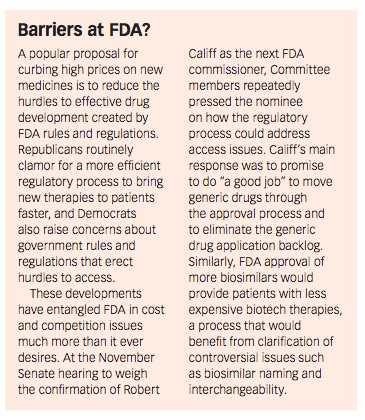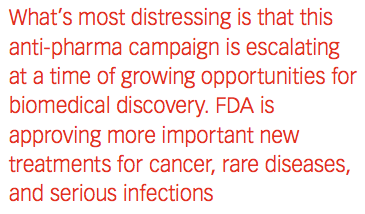Rough Road Ahead for Innovation
Pharmaceutical Executive
The continuing attack on industry pricing and marketing jeopardizes coverage, R&D.
The last few months have been tough for pharmaceutical companies, and the political environment in Washington isn’t likely to improve in the coming year. Total healthcare spending in the U.S. has begun to rise after several years of slow growth,
Jill Wechsler

primarily the result of increased coverage of individuals through Medicaid and private plans subsidized by the Affordable Care Act (ACA).â¨
But much blame goes to a rise in prescription drugs expenditures: the annual analysis by actuaries at the Centers for Medicare and Medicaid Services (CMS) finds that retail drug spending climbed a hefty 12.2% in 2014, largely due to big outlays for new hepatitis C treatments, along with only moderate expansion of generic drug prescribing as fewer blockbusters lost patent protection. ⨠At the same time, the surprise recovery of former president Jimmy Carter from a serious form of melanoma highlighted the life-saving potential of new PD-1 inhibitors for cancer. Press reports noted that treatment with Merck’sKeytruda (pembrolizumab) can cost up to $150,000 a year, but left open the burning issues of who should foot the bill and whether such prices are needed to cover the substantial cost of research to evaluate new combination therapies of this and other breakthrough medicines.
â¨Those issues will be front and center in 2016, as public and private payers seek to control drug outlays and presidential hopefuls promote a range of strategies, from curbs on advertising to importation of drugs from Canada. Democrats are leading the attack, which will shape initiatives to revise patent

policy, taxes, drug marketing, and coverage. Ongoing Republican efforts to repeal Obamacare also will have an impact: industry has supported the ACA as a way to extend drug benefits to millions of uninsured Americans, but confusion over which plans cover which drugs and unexpected high co-pays on specialty medicines adds to public disenchantment with the program.â¨
States also seek to limit consumer outlays for drugs and to revise Medicaid rebates and reimbursement policies. They’re establishing new laws and regulations that set monthly or annual caps on co-pays and cost-sharing for medicines or limits on plan deductions.
Other strategies look to limit specialty tiers in formularies or require access to plans with fixed co-payments. Drugmakers quietly back curbs on out-of-pocket drug spending, even though insurers are likely to respond with premium increases for some or all plans.⨠And federal enforcement agencies continue to build cases involving pharma marketing, pricing and financial disclosure, with an eye to collecting large settlements and bringing charges against individual executives.â¨â¨
Whither innovation�
A real danger is that the outcry over limited access to important therapies will erode support for increased federal funding and support for biomedical R&D. Incentives for developing orphan drugs and the related priority review voucher program are under scrutiny, as are proposals to extend exclusivity for certain new therapies.
What’s most distressing is that this anti-pharma campaign is escalating at a time of growing opportunities for biomedical discovery. FDA is approving more important new treatments for cancer, rare diseases, and serious infections, and a full industry pipeline promises more breakthrough therapies. Advances in diagnostics and genomic testing support a shift to more

personalized medical treatment after years of anticipation, and technological innovation is yielding more effective vaccines and therapeutics to prevent and combat killer diseases and potential epidemics.
These advances benefit from broader patient involvement in drug development, which supports a more balanced assessment of risks and benefits in evaluating the approval of therapies for serious conditions. The need to weigh innovation along with affordability was emphasized at the high-profile HHS Pharmaceutical Forum in November. Douglas Long, vice president of IMS Health, acknowledged that more new medicines in the pipeline will boost outlays for drugs for the near term, but save money overall due to reduced hospitalization and outpatient and emergency room visits. Former FDA and CMS head Mark McClellan and many others emphasized the need for outcomes-based insurance designs and other approaches that share financial risks of covering a new drug.
But CMS acting administrator Andy Slavitt complained at the HHS forum that the nation “shouldn’t have to choose between innovation and access.” He seeks more transparency in drug prices and discounts, along with more dialogue about value-based payment strategies, to support more rational purchasing and prescribing policies.
Despite widespread enthusiasm for considering the value of a medicine in coverage decisions, analysts admit that such calculations are very difficult due to wide differences in methods and assumptions in identifying risks and benefits. Variation in patient preferences makes it hard to set values on clinical effectiveness, reduced toxicity, improved delivery and dosing methods, alternative treatments, and overall cost-effectiveness. Thus, there are considerable obstacles to identifying high- and low-value interventions that warrant more or less reimbursement.
The challenge for pharma is to adopt more realistic models for setting and revising product prices. Forget claims that drugs account for only 10% of health care spending, or that hefty R&D expenditures warrant high return on investment. Or that a few “bad actors” are responsible for exorbitant price hikes. Pharma companies basically set prices for drugs based on who is paying and what the market will bear, and that’s no longer acceptable.
Jill Wechsler is Pharmaceutical Executive's Washington correspondent. She can be reached at jwechsler@advanstar.com

Addressing Disparities in Psoriasis Trials: Takeda's Strategies for Inclusivity in Clinical Research
April 14th 2025LaShell Robinson, Head of Global Feasibility and Trial Equity at Takeda, speaks about the company's strategies to engage patients in underrepresented populations in its phase III psoriasis trials.
Beyond the Prescription: Pharma's Role in Digital Health Conversations
April 1st 2025Join us for an insightful conversation with Jennifer Harakal, Head of Regulatory Affairs at Canopy Life Sciences, as we unpack the evolving intersection of social media and healthcare decisions. Discover how pharmaceutical companies can navigate regulatory challenges while meaningfully engaging with consumers in digital spaces. Jennifer shares expert strategies for responsible marketing, working with influencers, and creating educational content that bridges the gap between patients and healthcare providers. A must-listen for pharma marketers looking to build trust and compliance in today's social media landscape.